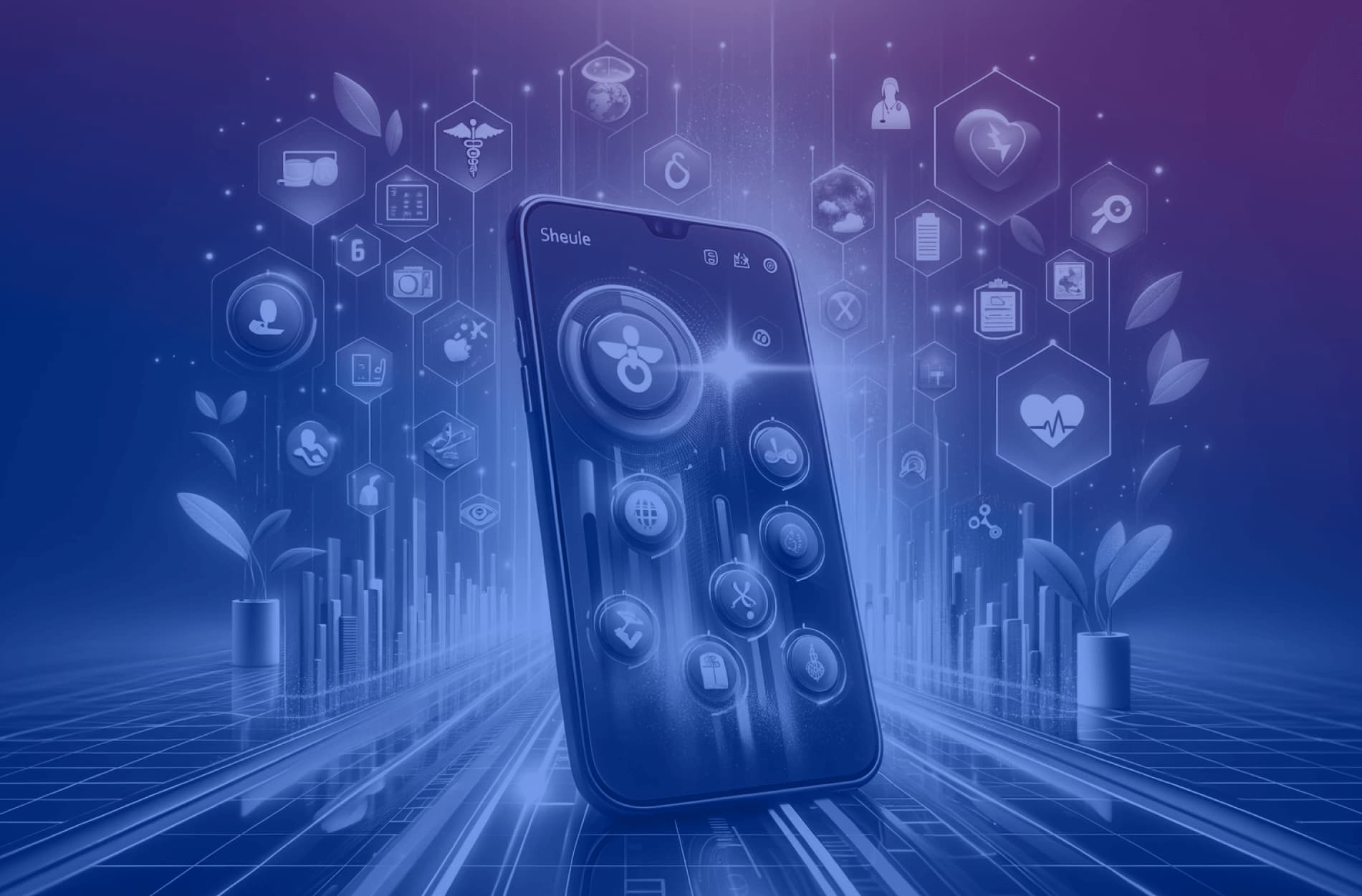
7 min read
Why digital health applications (DiGA) are the future – in conversation with ABAStroke
Legislative developments in the MedTech markets aren’t progressing as fast as the technologies and innovations in it...
but – especially over the last few years – they significantly sped up, opening new possibilities for digital therapeutics (DTx) apps and other healthcare software. One of the countries leading this change is Germany, with its simplified path for digital health applications (DiGA) to become reimbursable by the healthcare system. Since we’re working with one of our clients on building software that’s aimed to become a DiGA in 2024, we figured it would be best to ask them for their perspective in a quick Q&A, which you can find below. But first, let’s start with some basics.
Did you know?
You might come across the abbreviation DTx, which stands for digital therapeutics. What are they? DTx is a medical software that supports patients through illnesses, injuries, or disabilities. They can be used in many medical disciplines – psychotherapy, physiotherapy, diabetology, cardiology, and more.
DiGA Fast-Track - German response for digital health applications’ needs
Increased usage of mobile devices and new technologies is clearly visible in almost every area of our lives. However, many people have been reluctant to take advantage of those when it comes to matters that have to do with their health – until quite recently. The C0\/ID-19 pandemic has significantly sped up the adoption of digital health innovations – causing a 53% increase in the use of health-related apps over the past two years.
And so, the legal and healthcare systems had to follow – starting with EU-wide regulatory changes, such as the Medical Device Regulation (MDR), and moving on to legislation on the country level. Quite surprisingly, Germany – with one of the most complex and rigid healthcare systems in Europe – has been one of the first countries to embrace these developments and enable its citizens to use digital health apps to improve their wellbeing.
Digital health application on prescription
MDR helped clarify that some software can and should be treated as a medical device (SaMD) in Europe – and a similar approach has been taken by the FDA in the United States. Since medical devices can be prescribed, nothing now stands in the way of the same being true for medical apps that help detect, monitor, treat, or alleviate different medical conditions.
But, just as medications and medical aids need to follow specific certification procedures to become prescribable and refundable, so do digital health apps. For now, only a few countries have taken on the challenge of creating appropriate legislative environments for this to become possible. And Germany, with its Digital Health Application Regulation (Digitale Gesundheitsanwendungen-Verordnung – DiGAV) that came into force in April 2020.
If you’re still curious, you can read more about regulations, requirements, and challenges of creating DiGA in our article, but for now, let’s buckle down to ABAStroke’s story to get more real-life experience on how it is to be building a DiGA app.
DiGA is just the beginning – Q&A with Michał Ryś from ABAStroke
There’s no better way to learn about DiGA than helping to build one. Such is the case with one of our clients, ABAStroke. They’ve partnered up with us to build an app that’s a digital at-home rehabilitation of post-stroke cognitive deficits that utilizes ABA (Applied Behavior Analysis) methodology in combination with machine learning (AI) algorithms. If you’re here for the first time, just a quick follow up that at Revolve Healthcare, we take care of ISO 13485-compliant software development from start to finish.
In a quick Q&A with Michal Ryś, the CEO and co-founder of the startup, we dive deeper into the subject of digital health applications. We also explore how legislation in more and more countries brings on new opportunities for app creators, patients, and... entire healthcare systems!
Revolve Healthcare: How and why did the outlook of digital health applications change over the last few years?
Michał Ryś: Back in 2016, when we were telling people that we aim for our mobile to be prescribed (just like a medication), the reaction was usually a kind pat on the shoulder – one that meant they thought our business model sounded amazing, but also crazy. Over the years, regulators have done a great job to make this a reality though. First in the USA, then in Germany, they created legal frameworks that support the development and growth of this market.
And even though the COVID-19 pandemic has been nothing to be happy about, it – without a doubt – led to the biggest breakthroughs and sped everything up. People have been, quite literally, forced to start using digital healthcare solutions, which caused the biggest entry barrier to burst. Digital health applications stopped being perceived as gadgets for tech geeks and started to be seen as fully-fledged solutions in the medical sector.
Of course, the road ahead of us is still long and winding, but over the last few years, the market for digital health products has grown faster than anyone could have expected. In “normal” conditions, such developments would take 10 or 20 years – and some maybe even more.
RH: You’re a Polish company, but you decided to go through the DiGA Fast-Track and launch your app in Germany as the first market. Why’s that? And what are the next countries on the list?
MR: Germany has very precise requirements for mobile applications that can be refunded in its healthcare system. This helps in planning to expand to this market. While we’ve always been technologically strong in Poland, the business and legislative side of things haven’t been so great. And we’ll probably have to wait a little longer before business catches up with tech.
In the meantime, the German healthcare system is very straightforward about its needs and expectations, so this country seems ideal as the first market for a digital health application. The next obvious targets are other countries of the European Union since becoming certified with a CE mark class IIa under MDR (one of the key DiGA pre-requisites) opens a path to enter each of those markets.
But even though the EU seems like the natural way for us to expand, we’re also looking at the United States. It’s a market we know well – from our past experiences with building a mobile health app. At the same time, that’s where about 20% of the global market is from ABAStroke’s perspective. However, entering the US requires getting FDA approval – and that’s a complex process that will take a while to go through.
RH: Is it difficult to become a DiGA in Germany? What are the key challenges?
MR: Actually, it’s quite “simple”. I mean, apart from building a great product (which is always key), in our case there are four things we need to do to become a DiGA:
- prove the clinical effectiveness of the digital product you’ve created,
- ensure the highest level of privacy and security,
- become ISO 13485 and ISO 27001 certified,
- and – in the end – get the CE mark as a medical product of class IIa (MDR).
Once you have all that, you just need to fill in the BfArM application and wait for up to 3 months to obtain the DiGA status and price negotiations with GKV-SV (National Association of Statutory Health Insurance Funds). And then, voilà, your app is refunded in Germany.
RH: Is Germany a good place to launch a digital health application? Would you recommend others to also start there?
MR: If you’re talking about the refundation model, then absolutely. ABAStroke is following this path exactly since we aim to become a participant in the healthcare system. But you need to remember that there are other ways for a digital health app to enter the market. For example, you can use a standard SaaS model to get to the patients and doctors. I’m not a fan of this solution though, since it relies much more on marketing than clinical effectiveness. But if you’re considering it, I think the US market would be the best one to launch in first.
RH: MDR, CE, ISO 13485 and 27001... There are a lot of regulations and standards you need to comply with if you want to become a DiGA. How do you wrap your head around all that?
MR: You have to have your timeline and calendar figured out, hire the best people, and work with top subcontractors. In our case, Revolve Healthcare helps a lot as our key technology partner. The company is ISO 13485 certified and takes care of the technical documentation that will become the basis of our certification process.
In general, if you’re planning to get a CE mark as a class IIa medical product under MDR, I would suggest starting to prepare for it about two years in advance. This will allow you to coordinate everything at a comfortable pace – with just the right amount of pressure.
Where to start?
If you’d like to talk with Michał in more detail on ABA Stroke’s application don’t hesitate to reach out to us - we will connect you through. In the meantime we can help you out with our complete article guide on what DiGA is, where we explain the requirements of creating a digital health app on prescription.
Secondly, you can read The Fast-Track Process for Digital Health Applications – a document prepared by BfArM for people interested in undergoing the DiGA assessment process.
Remember that you don’t have to go through the Fast-Track Process alone. We would be happy to share our knowledge with you. Feel free to contact us - we can talk to you anytime.
